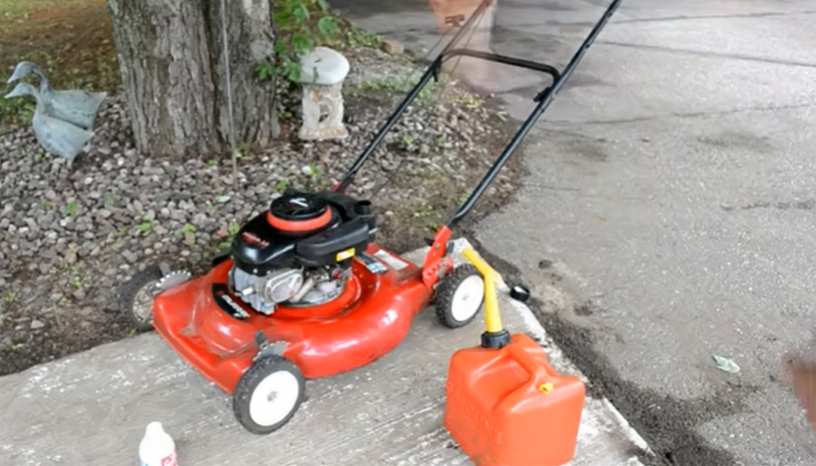It is not easy to imagine that gasoline can go bad, but the truth is that gas disintegrates over time and becomes unsuitable for machinery, including lawnmowers. So, can old gas cause a lawn mower not to start?
Yes, old gas can cause your lawn mower not to start. Gasoline can go bad in as little as 3 to 4 weeks. When stored for long without a stabilizer, fuel undergoes oxidation and evaporation, making it lose its combustibility.

Can Old Gas Cause a lawn Mower Not to Start?
Over time, gas is likely to lose its combustibility properties due to oxidation and evaporation. Gasoline that’s gone bad can damage the internal components of the engine. It may start to form a gum residue that could cause blockages in the carburetor and fuel lines.
Old ethanol-based gasoline may draw water vapor into your fuel line or gas tank, which could result in internal corrosion. Water in the gas lawn mower tank mixed with gas won’t support combustion. This typically stops a lawn mower from starting at all.
If you are lucky to start your mower with bad fuel, you will likely run into other problems. Your lawn mower will keep sputtering and may even stall.
How to Fix Bad Gas in your Lawn Mower
If your lawn mower doesn’t start after sitting or dies during operation as a result of bad gas, then you have to do several things to bring the machine back to life. Before you start, disconnect the spark plug cable as a safety measure.
- Start by removing all the sediment and residue build-up in the tank. Refer to the owner’s manual for service procedures and information on how to remove the build-up from the fuel tank.
- Drain all the bad gas from the fuel tank. Run a siphon hose from the gas tank to a container and pump the bulb to pull out gas from the fuel tank.
- Disassemble the carburetor and clean it to remove any sediments and residue buildup.
- If there are any blocked fuel lines, you may need to replace them. This may require the help of an expert or an authorized dealer.
- Assemble back everything and add new fuel to the fuel tank and try to start your lawn mower.
If your lawn mower is not starting after the restoration, check if the spark plug is in good condition and if its cable is well connected. You may also need to clean or replace the spark plug if worn out or damaged.
A lawn mower battery can also go flat if stored for longer, especially during the cold winter. If your lawn mower relies on battery power to start, then this is an area you should also check. Try to jumpstart your lawn mower or replace the battery.
How to Prevent Lawn Mower Old Gas Problems
In most cases, lawn mower fuel will go bad during the long winter storage. However, this problem can be prevented by properly winterizing your lawn mower before storage.
If you intend to store your lawn mower for longer without using, here’s what you need to do:
Remove all the remaining fuel from the tank
Emptying the lawn mower fuel tank before winter storage is one of the easiest ways of preventing bad fuel problems when spring comes. You can run your lawn mower engine until all the gasoline is combusted or drain all the remaining gas from your lawn mower tank using a siphon pump.
To ensure that no fuel remains in the system after the draining, start the lawn mower and let the engine run until it stops due to lack of fuel. However, experts discourage emptying a mower’s tank as it can still lead to moisture condensing in the fuel tank during a cold winter.
Add storage-grade fuel stabilizer.
Adding a specialized storage-grade fuel stabilizer to your lawn mower is an effective way of dealing with bad fuel problems. A stabilizer can keep gasoline fresh for more than one year.
The product slows fuel oxidation or breaks down water into dispersed droplets. This method begins by draining all the fuel from the tank. This will inform you exactly how much fuel you should add as prescribed on the fuel stabilizer label.
Next, choose a storage-grade fuel stabilizer recommended for your lawn mower type and add the recommended amount into the empty fuel tank. Add new fuel to top the tank to 95% to avoid fuel spills.
Run the lawn mower engine for 10 minutes so the stabilized fuel can move through the engine and carburetor. Finally, stop your lawn mower engine, let it cool down, and store it in a clean, dry place.
What to do With Old Gas
Now that you have siphoned the bad gas from your lawn mower fuel tank, what do you do with it? New York State Department of Environmental Conservation explains that old gasoline can be reconditioned and used in trucks, cars, lawnmowers, and other engines.
However, this will depend on how old or contaminated gasoline is and probably what your owner’s manual recommends on using reconditioned oil in your engine.
Gasoline contaminated with other engine fluids, such as oil, brake fluid, transmission fluid, or antifreeze, should not be reconditioned or reused; it should be disposed of.
Gasoline is highly toxic and flammable therefore should not be poured into storm drains, septic systems, or on the ground. It should also not be disposed of with other regular household garbage or recycling.
Disposal of gasoline should be done through your local household hazardous waste program.
Final Thought
Without stabilizing fuel in your lawn mower for longer storage, it will go bad in weeks. Bad fuel not only gives a hard start in spring but also damages your engine. Replacing the bad fuel with fresh is a quick fix to this problem.